If there’s one dish that is quintessential during the fasting or vrat season in the Indian subcontinent, it has to be Sabudana Khichdi. Made with sago pearls or sabudana, boiled potatoes, roasted peanuts and a few spices, Sabudana Khichdi Recipe is most popular during the fasting days of Hindu festivals like Navratri, Mahashivratri and Ekadashi. Many people have many ways of making it. However, here, I have shared many to-dos for the most perfect, non-sticky Maharashtrian style khichdi made with sabudana. This is the recipe I have been making for decades.
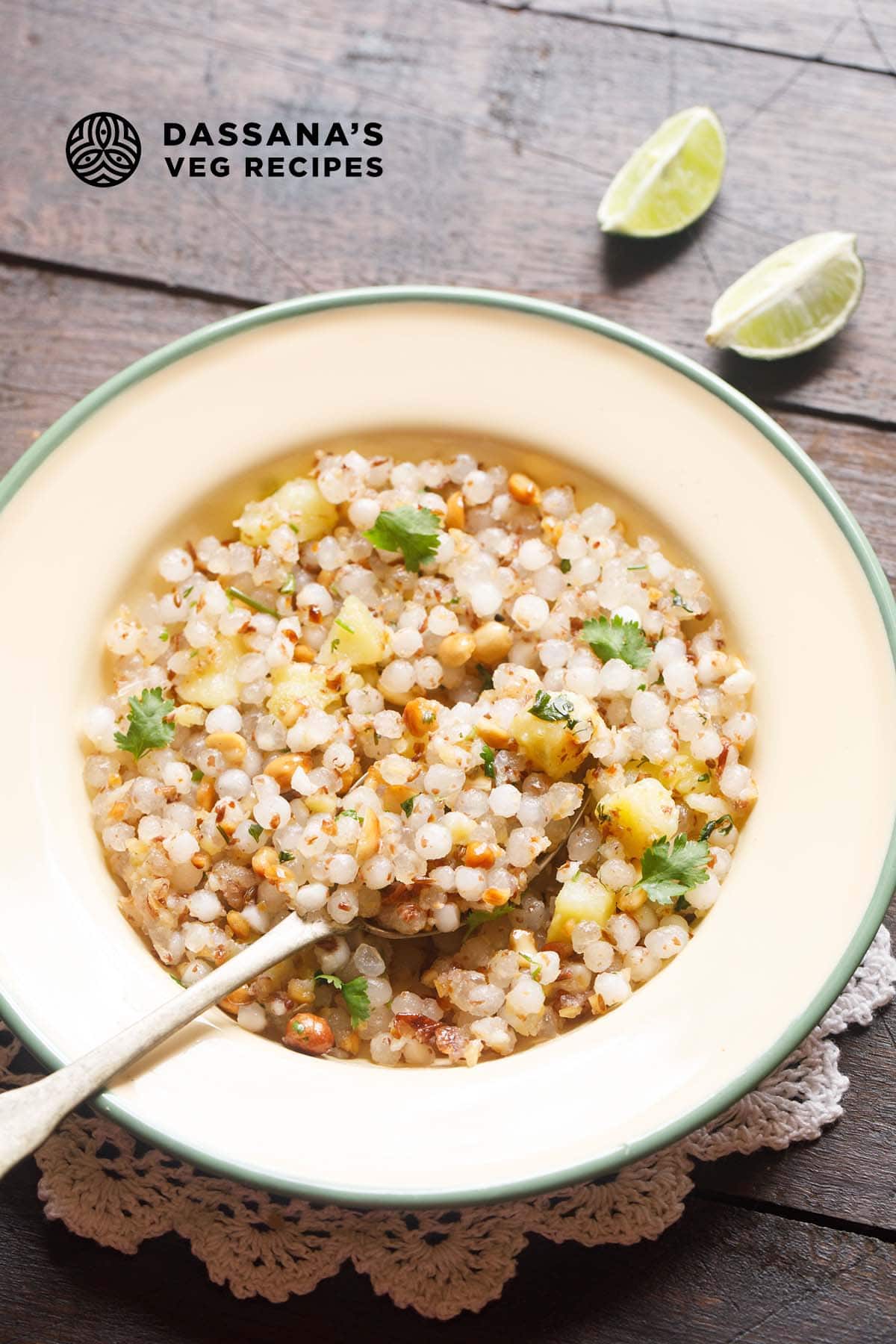
Why You’ll Love This Sabudana Khichdi
This Sabudana Khichdi recipe is an easy and delicious snack that can be made during your vrats or fasting days. However, it does require some skill and experience to make this khichdi, in which the sabudana pearls are not sticking or have turned into a lumpy mass.
Sabudana is the Hindi term for ‘sago’ or ‘tapioca pearls,’ and are made from the roots of the cassava plant. Another name of this plant is tapioca or yuca.
Since it is naturally a plant-based foodstuff and is gluten free as well, it is a great vegan alternative as well as a tasty substitute for wheat-based flours too. Another sago favorite of mine is this Sabudana Vada.
When you make Sabudana Khichdi, you have to adjust the soaking time as per the type of tapioca or sago pearls. For some varieties, 2 to 3 hours is fine and for some you may need to soak for more than 3 hours or overnight. So, do soak the sabudana pearls accordingly.
Table of Contents
For soaking, just cover the sago pearls with water for some time and you are done. I have mentioned in the steps below, on how to test the soaked sabudana pearls that are perfect to be used in the recipe.
Also, in this Sabudana Khichdi Recipe, I have demonstrated the step-by-step version of soaking the sago pearls overnight. However, you are free to adapt the soaking time as per the quality of tapioca pearls you have.
This Sabudana Khichdi is not just a yummy dish that I have grown up having, umpteen times. It is loaded with carbohydrates and the proteins coming only from peanuts. Sabudana is rich in carbs, and hence this dish makes for a filling snack.
How to make Sabudana Khichdi
Soak Sabudana
1. Rinse 1 cup sabudana, sago or tapioca pearls a couple of times in running water until all the starch is washed away. You can use a colander while rinsing.
Soak sabudana in water. The water level can be 1.5 to 2 inches above the sabudana.
In the picture below, sabudana pearls are already soaked. Depending on the quality of sabudana, you can soak them overnight or for some hours.
I always soak them overnight, since even after soaking them for 2 to 3 hours, they don’t soften.
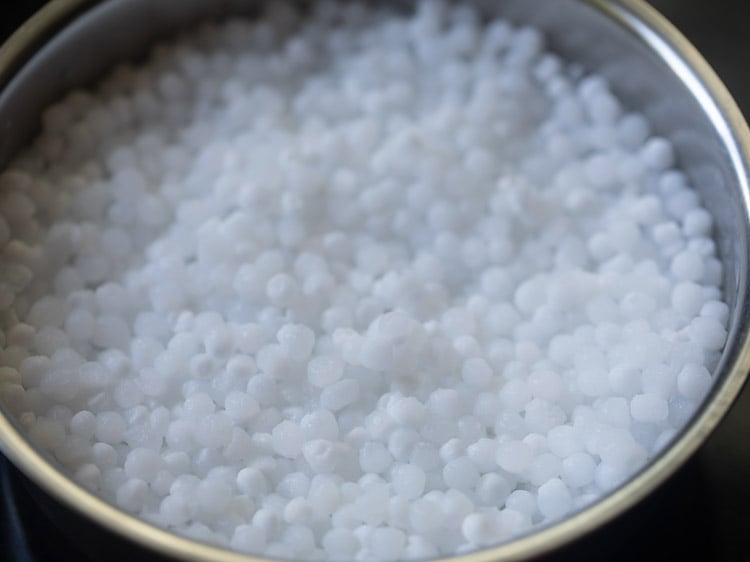
2. To check if sabudana has become soft or not, you should be able to easily press the sabudana and it should get mashed easily.
If there is some hardness in the center of the sago pearls, then add a few tablespoons of water in the bowl. Cover and leave for 30 minutes more.
Note that the pearls have to be softened thoroughly. If the center is hard, the khichdi will not have a good texture as sabudana will not cook well.
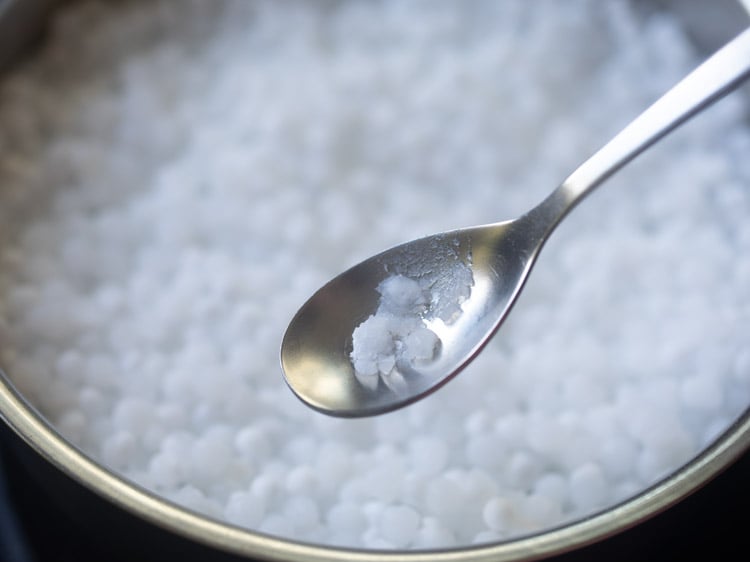
3. Using a strainer or colander, strain all the water from sabudana. Strain very well as there should be no extra water in the sabudana. Keep aside.
Remember to drain the water really very well. Any water logged in the sago pearls will make your khichdi mushy or pasty.
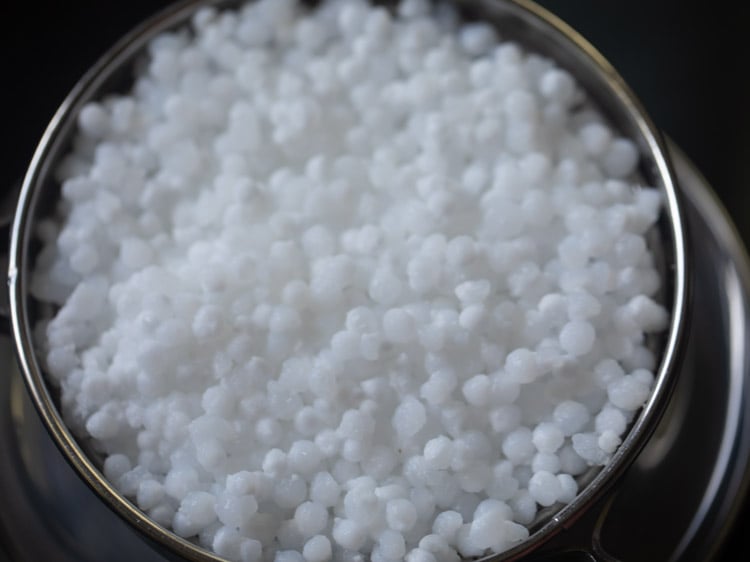
Cook Potatoes
4. While sabudana is getting soaked, you can boil 2 medium-sized potatoes in a pan or in a cooker and keep aside.
For pressure cooking, just add enough water covering the potatoes and then pressure cook on medium heat for 4 to 5 whistles.
You can also steam the potatoes in an Instant Pot, adding required amount of water.
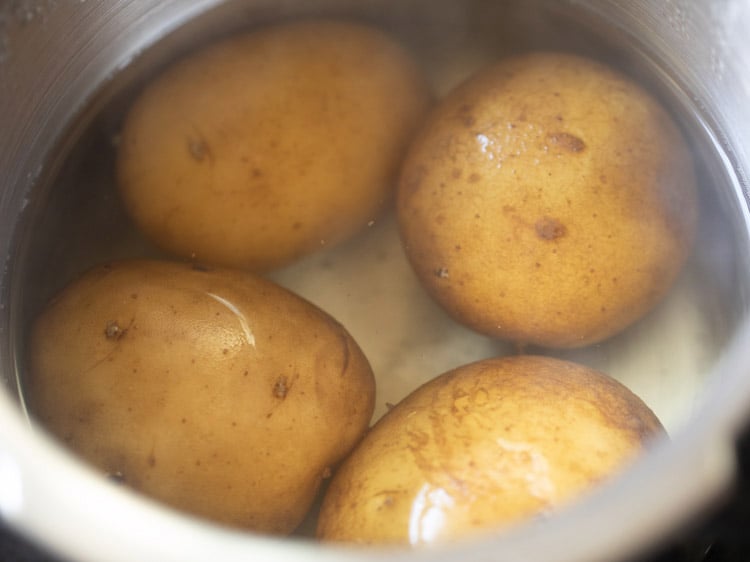
5. When the pressure settles down naturally in the cooker, then only open the lid. Remove the potatoes and let them become warm or cool completely. Then, peel and chop them.
Instead of boiling potatoes, you can even shallow fry potatoes and then add them to the khichdi.
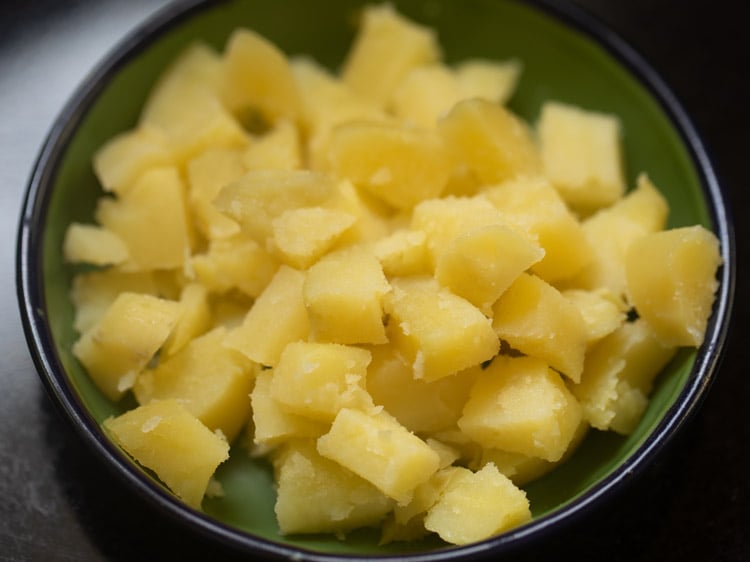
Make Peanut Powder
6. Heat a kadai (wok) or a frying pan. Add ½ cup peanuts (moongphali).
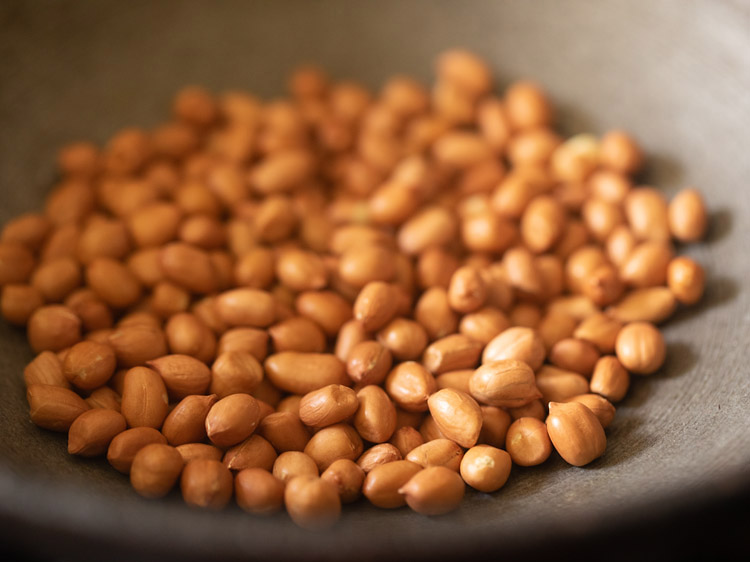
7. Keep heat to medium-low and stirring often, roast the peanuts.
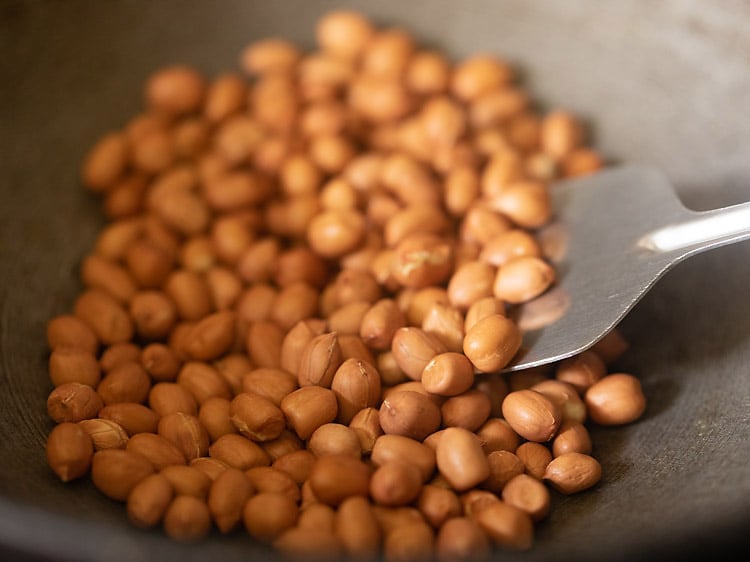
8. Roast till the peanuts become crunchy. You will see the peanut skins getting browned or charred.
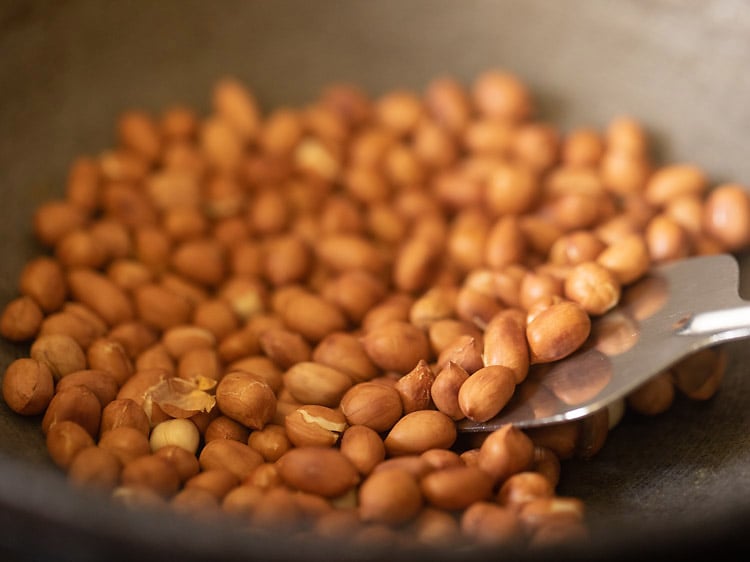
9. Turn off the heat and keep the peanuts aside to cool. You can remove the peanut skins, if you want.
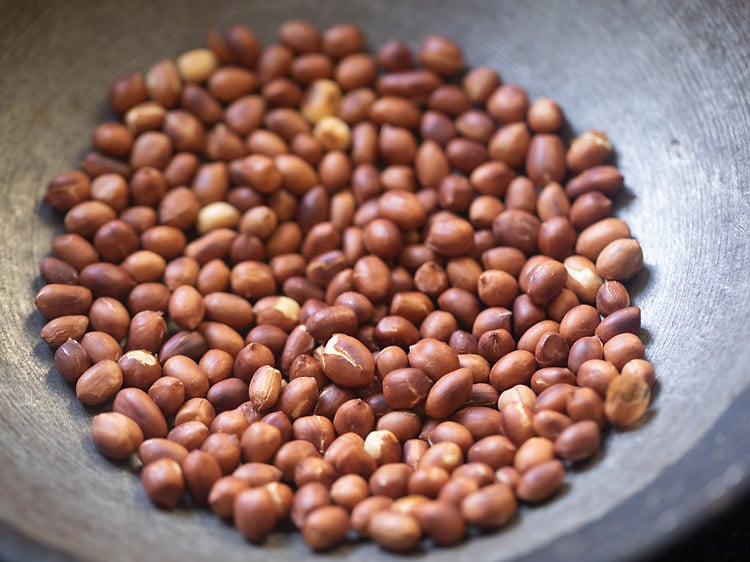
10. Add the cooled roasted peanuts in a small grinder jar or blender.
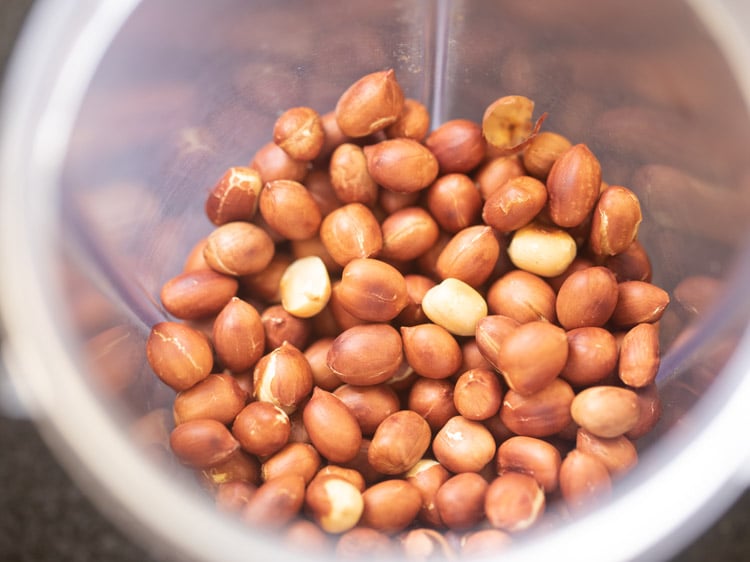
11. Using the pulse option, powder the peanuts coarsely. Do not grind at a stretch, as then the peanuts will release their fat.
Grind in parts and for a few seconds as we just need to make a coarse or semi-fine peanut powder. You can even coarsely powder the peanuts in a mortar-pestle.
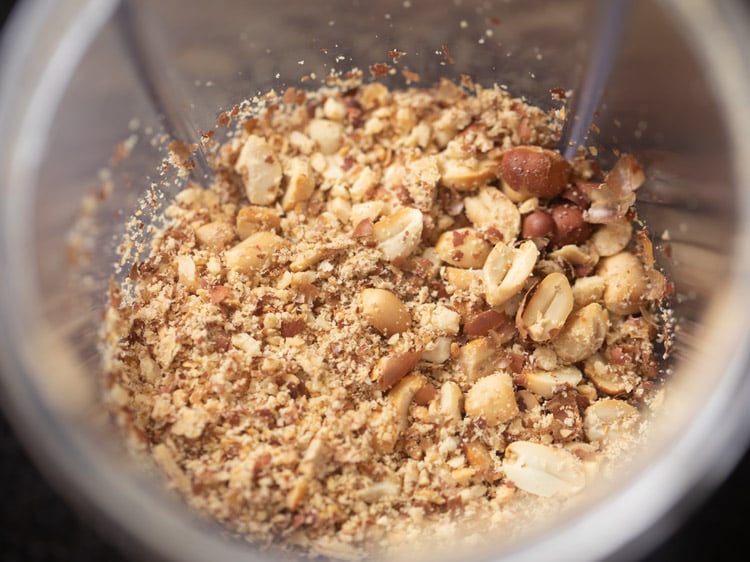
12. Take the well drained and soaked sago pearls in a mixing bowl, plate or tray. Then, add the ground peanut powder in to it.
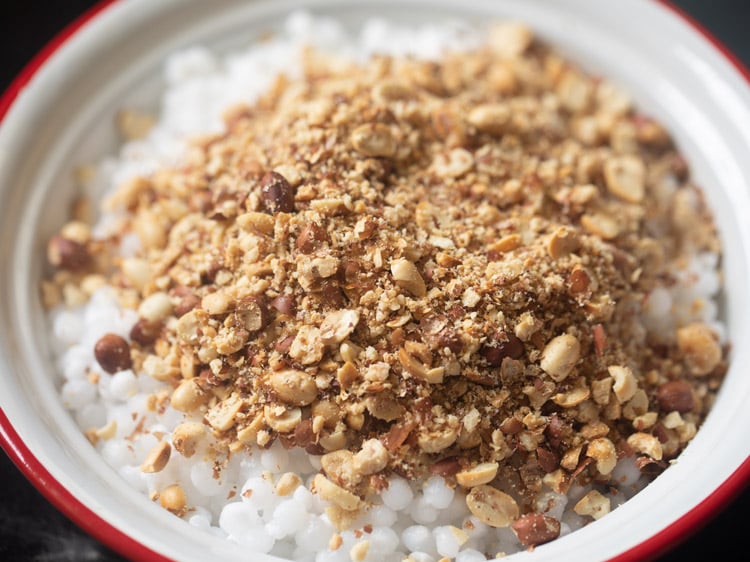
13. Also add edible rock salt (sendha namak) as per taste and ½ to 1 teaspoon sugar.
In the Hindu fasting food, we use rock salt. If making this dish on regular or non-fasting days, then you can swap rock salt with regular salt.
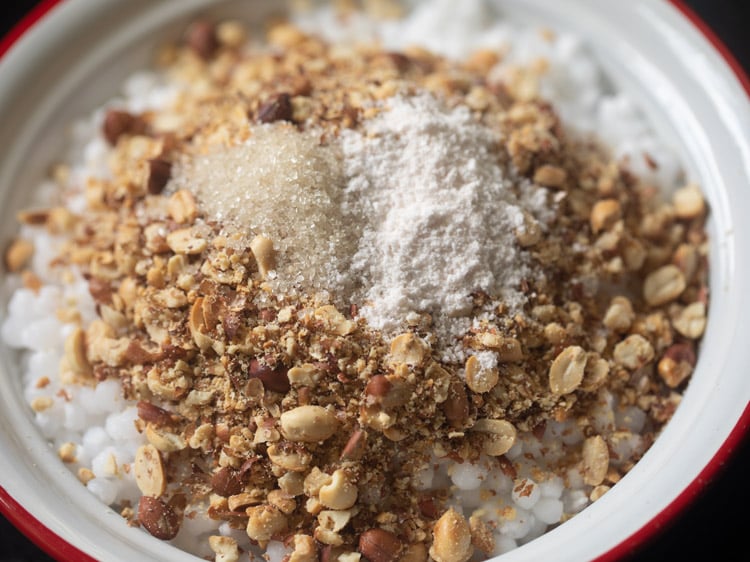
14. Mix very well with a spoon.
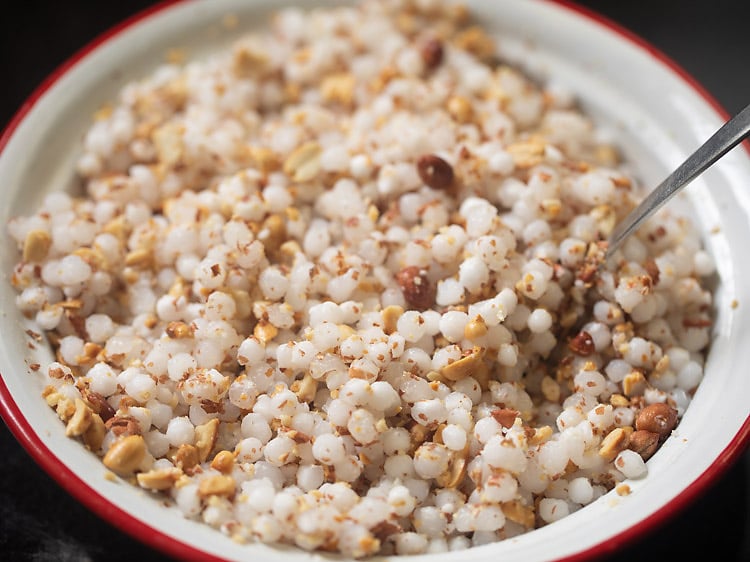
Make Sabudana Khichdi
15. Heat 3 tablespoons peanut oil or ghee (or your preferred oil) in a heavy kadai or pan. Keep the heat to a low or medium-low.
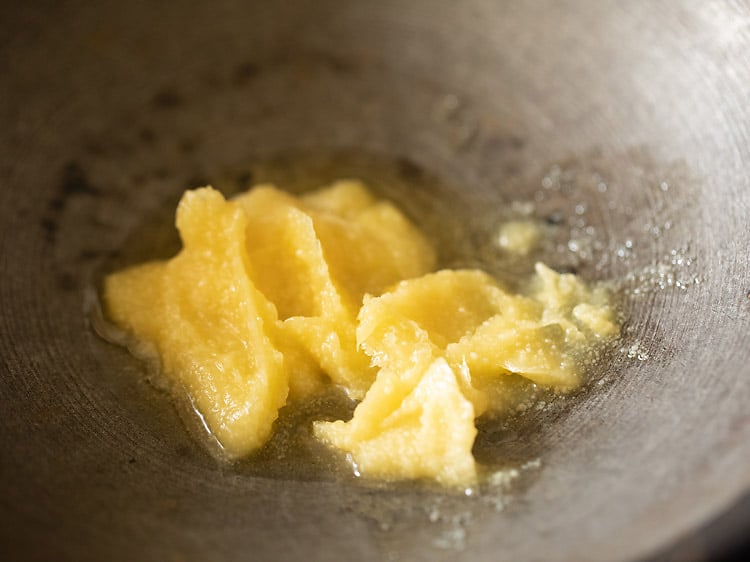
16. Add 1 teaspoon cumin seeds.
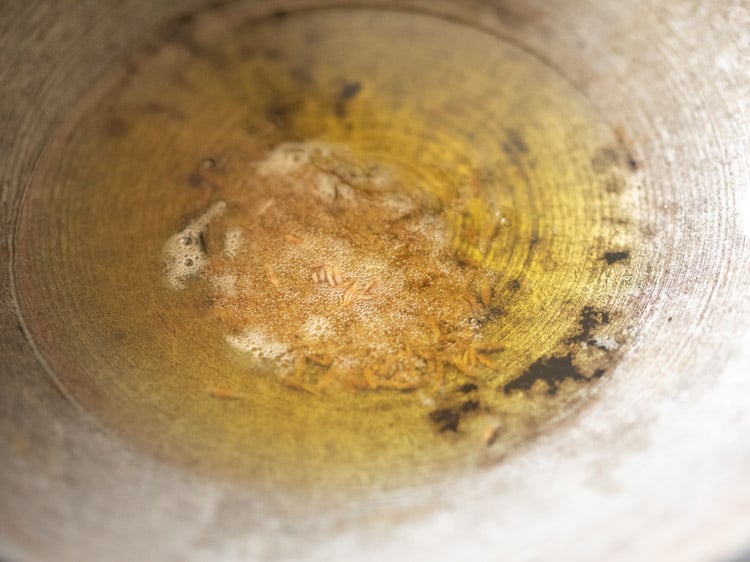
17. Let them crackle and get browned.
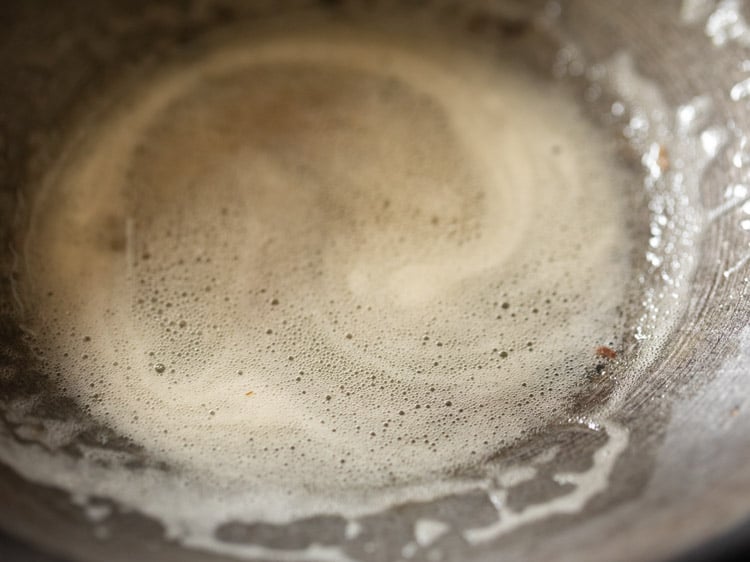
18. Then, add 1 chopped green chilli (about ½ to 1 teaspoon, chopped).
I do not add curry leaves to the sabudana khichdi that I make during the fasting or vrat. But accordingly as followed in your family, if curry leaves are allowed as a fasting ingredient, you can choose to add them.
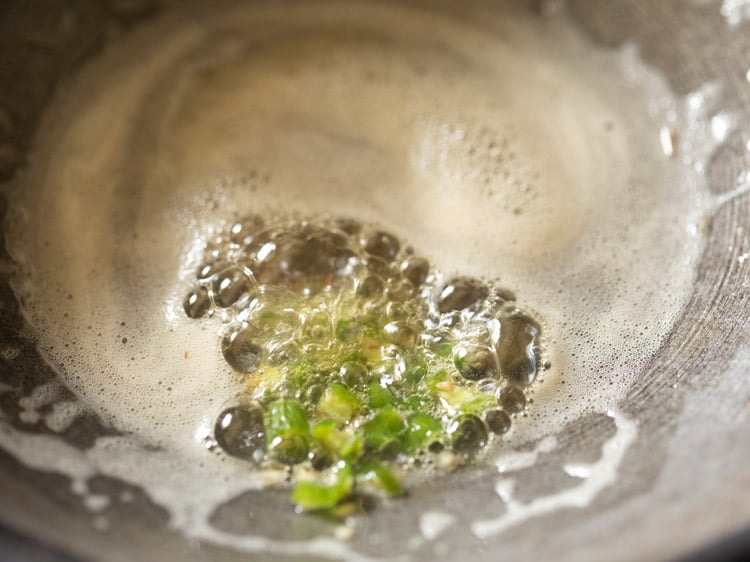
19. Fry on medium-low heat for a few seconds.
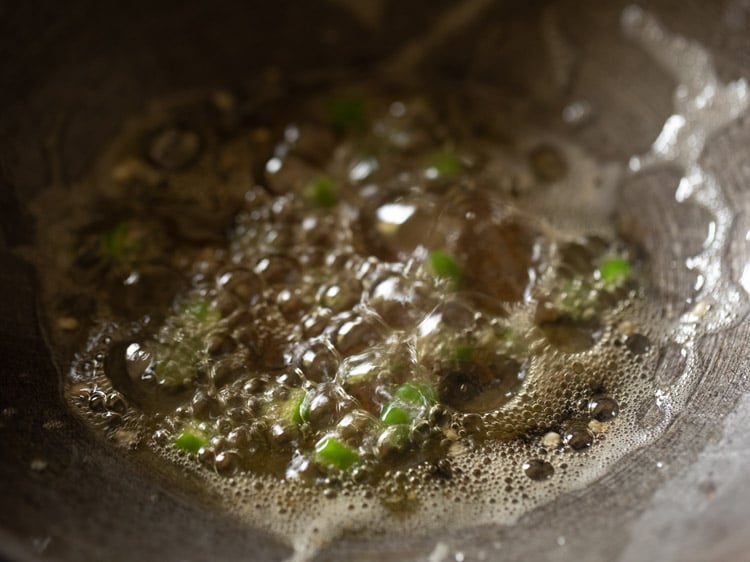
20. Now, add the chopped boiled potatoes.
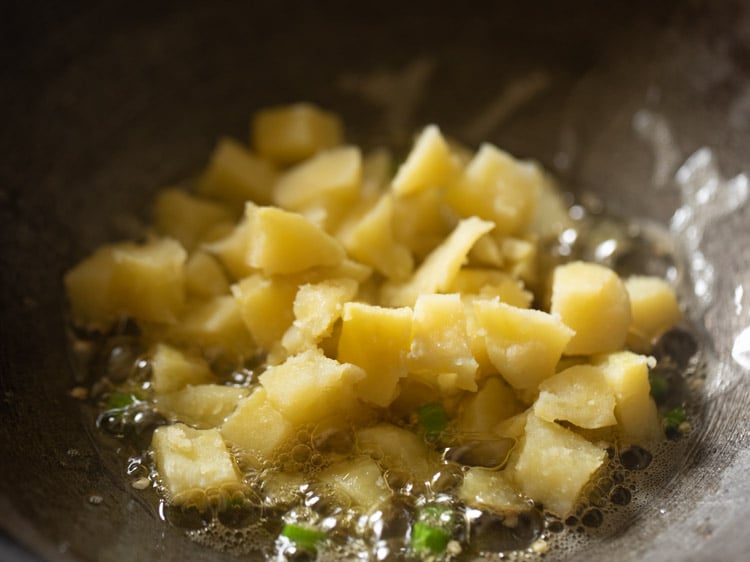
21. Mix and sauté on medium-low heat for a minute.
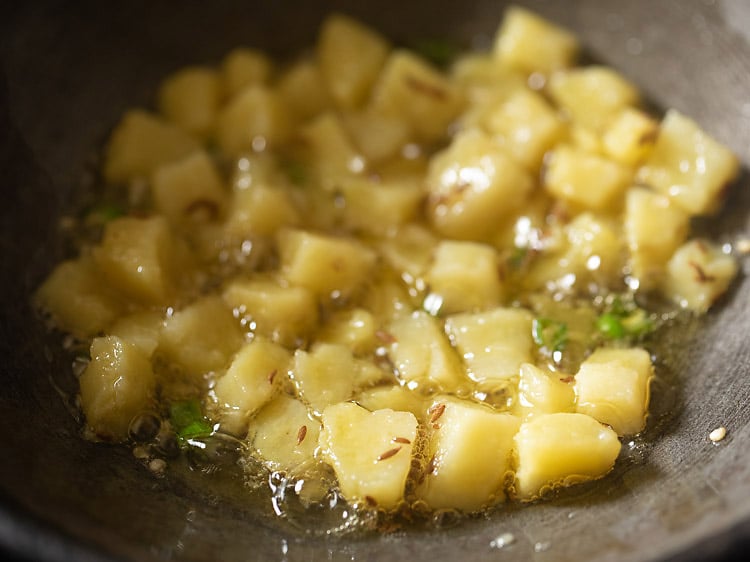
22. Next, add the sabudana-peanut powder mixture.
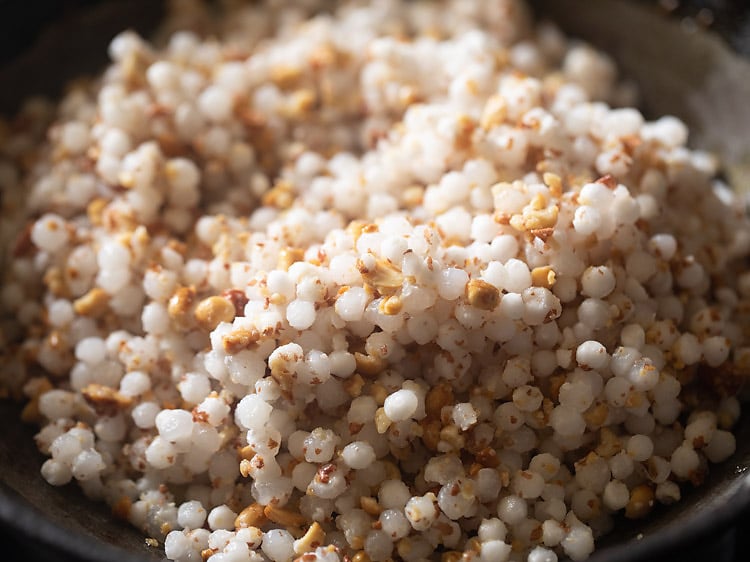
23. Mix very well.
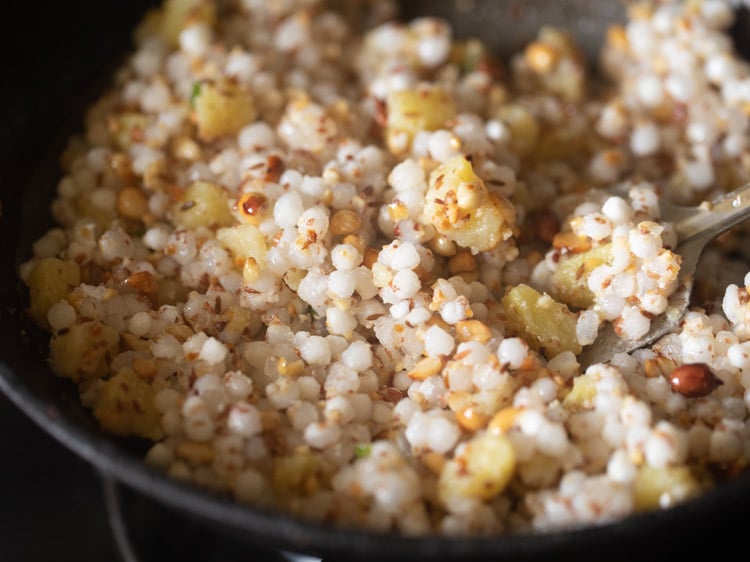
24. Sauté on a low heat, stirring continuously, for about 3 to 5 minutes.
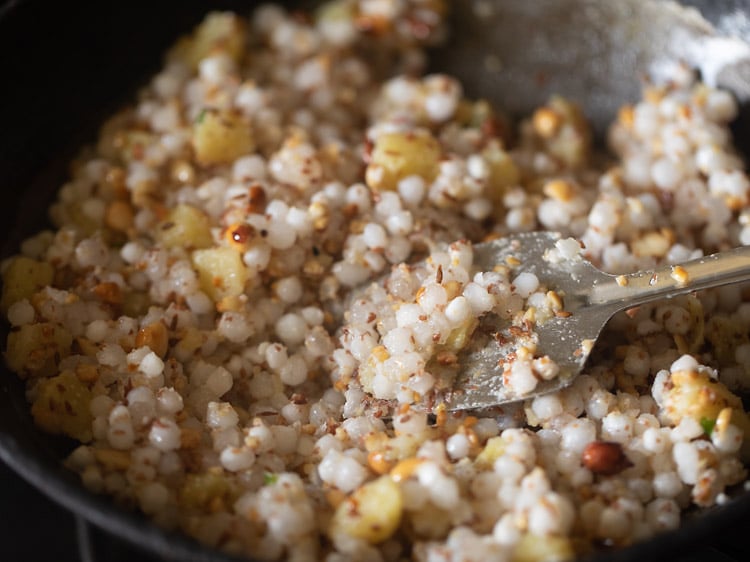
25. Sauté till the sago pearls becomes translucent. Taste a few cooked sabudana pearls. You should not get a raw taste.
Once cooked, turn off the heat. Do not overcook as the sabudana can become lumpy and chewy.
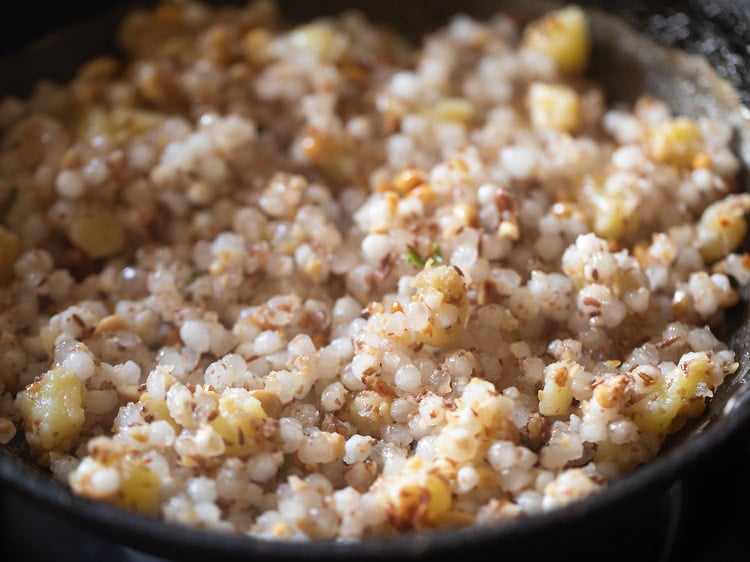
26. Then, add 1 teaspoon lemon juice for some tang.
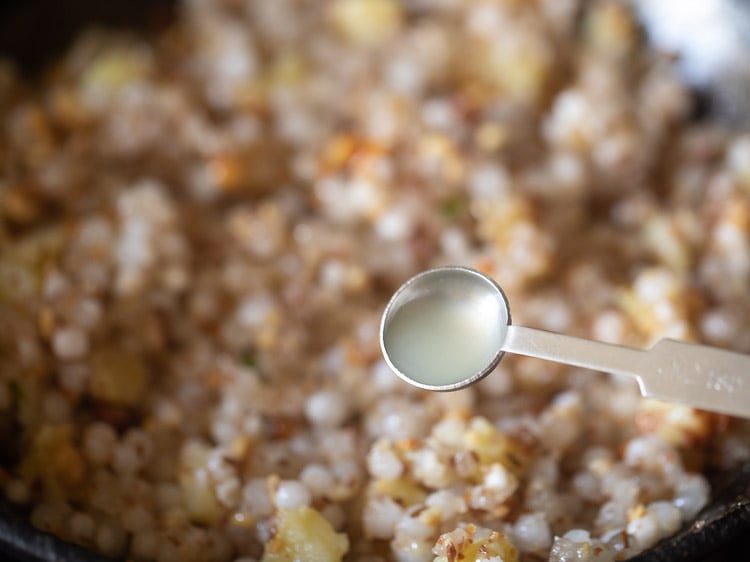
27. Add 1 to 2 tablespoons chopped coriander leaves. If you do not eat coriander leaves during fasting, then you can skip them.
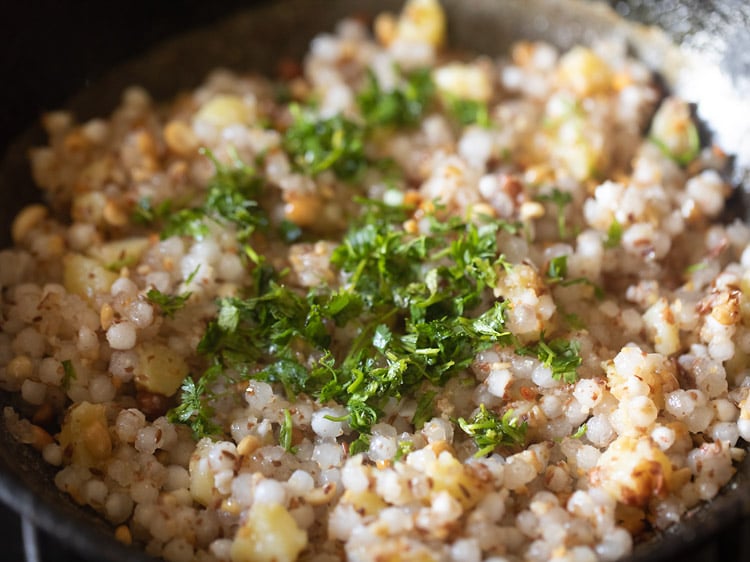
28. Mix well.
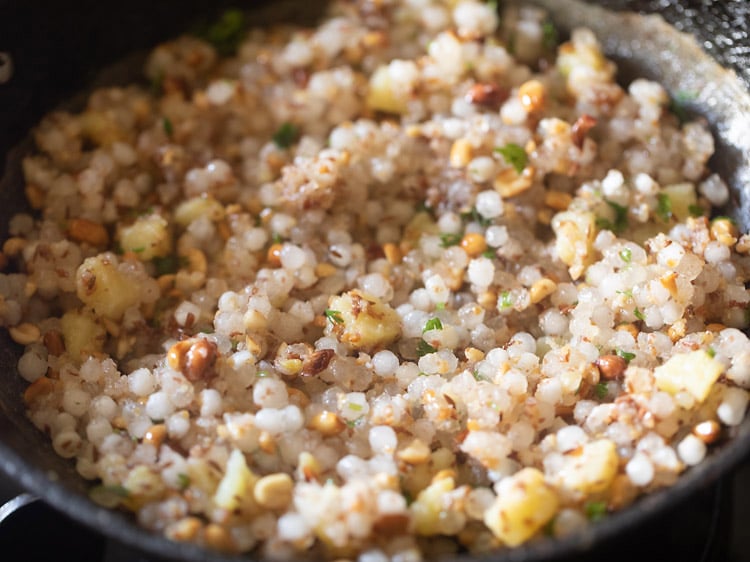
29. Serve Sabudana Khichdi hot or warm. While serving, you can also garnish with a few coriander leaves and some grated fresh coconut.
You can eat sago khichdi as is or with a side of sweetened curd (yogurt) or coconut chutney that is specifically made for fasting days.
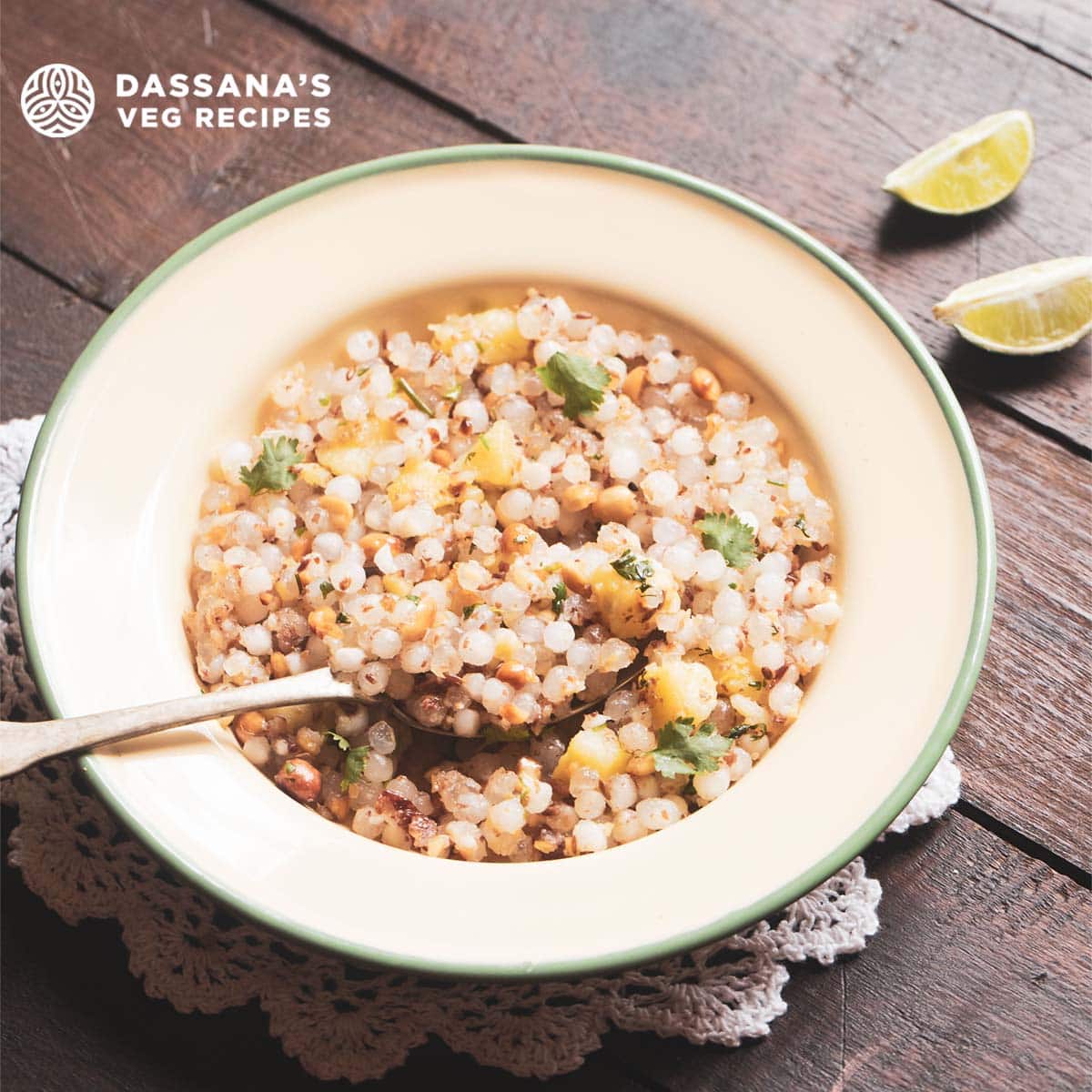
Expert Tips
- Rinsing Sago: Rinse the sabudana pearls in a colander, under running water, very well until you feel that all the starch is rinsed and washed away. This thorough rinsing aids to clear out the excess starch that causes the sabudana khichdi to become lumpy, mushy and sticky.
- Soaking Sago: Transfer the washed and drained sabudana in a bowl. Add water with its level just above 1 to 1.5 inches in the bowl. Cover the bowl and leave the sabudana pearls for 3 to 4 hours or overnight. The time duration will depend on the quality of sabudana pearls.
- Sabudana Quality: Depending on the quality of sabudana, it can take less or more hours for soaking or will require less or more water. Before cooking, check the soaked sabudana. Press a few pearls. They should mash easily.
- Sabudana not soaked well: If you feel some hardness in the center, add few tablespoons water and leave for 30 minutes more. If the sabudana is not soaked properly and the center is hard, it won’t cook well. For a good texture and taste, the soaked sabudana has to be softened well.
- Straining soaked sabudana: Using a colander or sieve, strain the water from the sabudana well. Excess moisture can make the khichdi mushy, sticky, lumpy and pasty.
- Pan Type: Use a well-seasoned, thick bottomed and heavy frying pan or wok to make this dish. A light weight or a non-seasoned pan may lead to the sabudana sticking to the pan and even getting browned.
- Scaling: You can easily halve or double this Sago Khichdi Recipe.
More Tips
- Cooking Potatoes: Potatoes can be boiled, steamed or fried before adding to the khichdi. I always boil them and sometimes I shallow fry them separately. Take care to cook them until fork tender only.
- Fats: You can use peanut oil or ghee to cook this khichdi. Or opt to use the fat of your choice or the one which you usually use to cook your fasting or vrat food.
- Cooking sabudana: Remember not to overcook sabudana, as it can become dry, chewy and dense. It should have a nice softness after being cooked.
- Herbs and Spices: Green chillies and coriander leaves can be skipped. Feel free to include or exclude the spices or herbs that you generally use during the fasting.
- Salt: If making the khichdi for fasting days, add edible rock salt (sendha namak) in the khichdi. For non-fasting days, you can add regular salt.
Variations
In addition to my Sabudana Khichdi Recipe on this post, here’s another variation to make this vrat-friendly dish. This version was shared by one of my readers, Minal.
According to her method, cooking the Sago Khichdi in a frying pan kind of helps in keeping the tapioca pearls dry and separated. Besides, having to use very little oil.
This is how you proceed:
- In a frying pan heat oil, add cumin seeds (jeera) and curry leaves and fry a little. Then, add potatoes cut into small cubes and fry on sim (low heat) till the potatoes cook. Alternately, you can cover with a lid to speed up the cooking.
- In the meantime, mix together soaked and drained sabudana, crushed peanuts or peanut powder, chopped coriander leaves (cilantro), salt, some black pepper powder, red chili powder, chopped green chilies and mix well with your hand. Keep aside.
- Check if the potatoes are cooked. Once done, add the prepared sabudana mixture to the potatoes and mix well.
- Adjust salt, drizzle very little water on the mixture, cover and cook on low heat for 2 minutes.
- Mix well and enjoy sago khichdi.
More Sabudana Recipes To Try!
Navratri & Fasting Recipes
Navratri & Fasting Recipes
Navratri & Fasting Recipes
Sabudana Chivda Recipe | Sabudana Namkeen Recipe | Sabudana Snacks
South Indian Food
Please be sure to rate the recipe in the recipe card or leave a comment below if you have made it. For more vegetarian inspirations, Sign Up for my emails or follow me on Instagram, Youtube, Facebook, Pinterest or Twitter.
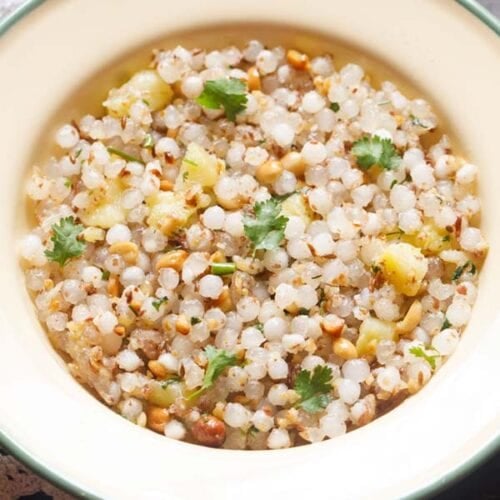
Sabudana Khichdi Recipe
Ingredients
- 1 cup sabudana – sago or tapioca pearls, 150 grams
- water as required, to soak sabudana
- 2 potatoes – medium-sized
- ½ cup peanuts – roasted
- 8 to 10 curry leaves – optional
- 1 teaspoon grated ginger – optional
- 1 green chili – chopped or ½ to 1 teaspoon
- 1 teaspoon cumin seeds
- ¼ cup coconut – grated, fresh – optional
- ½ to 1 teaspoon sugar or as required
- ½ to 1 teaspoon lemon juice (optional) or as required
- 3 tablespoons peanut oil or ghee
- rock salt – edible and food grade, (sendha namak) as required
- 1 to 2 tablespoons coriander leaves – chopped, optional
Instructions
Preparation
- Rinse sabudana very well in water. Then soak sabudana overnight or for 3 to 5 hours.
- After the sabudana has soaked well enough, check if they have become soft or not.
- To do this take a few pearls and press them with your fingers. They should get mashed easily. If you feel some hardness in the center of the sabudana pearls, then add a few tablespoons of water in the bowl. Cover and leave to soak for 30 minutes more.
- Drain the soaked sabudana very well of all the water and set aside.
- Boil the potatoes and when warm peel and chop them.
- In a pan, dry roast the peanuts till browned and when cooled make a coarse powder in a mortar-pestle or in a dry grinder.
- Mix the coarsely powdered peanuts, salt and sugar with the drained sabudana.
Making sabudana khichdi
- Now heat peanut oil or ghee. Fry the cumin first till they crackle and get browned on low to medium-low heat.
- Now add the curry leaves if using and green chillies. Fry for a few seconds and then add the grated ginger if using. Both curry leaves and ginger are optional and can be skipped.
- Saute for a couple of seconds till the raw aroma of the ginger goes away. Now add chopped boiled potatoes and saute for a minute.
- Add the sabudana. Keep on stirring often on a low heat for about 3 to 5 minutes.
- When the sabudana loses their opaqueness and starts becoming translucent they are cooked.
- Don’t overcook as they might become lumpy and hard.
- Turn off the heat and add lemon juice and chopped coriander leaves. Mix well.
- While serving garnish with a few coriander leaves and drizzle with some lemon juice. You can even add some grated fresh coconut on top.
- Serve Sabudana Khichdi hot or warm as is. Or you can serve with a side of sweetened curd or a satvik coconut chutney made with fasting ingredients.
Video
Notes
- Rinse the sabudana pearls very well in water to get rid of excess starch.
- Depending on the quality of sabudana you soak them in less or more water or for less or more time. If the sabudana is not soaked properly and if the center is hard then it won’t cook well. For a good texture and taste in the khichdi, the soaked sabudana has to be softened really well.
- After the sabudana pearls are soaked well, drain all the water very well. If there is any water left then this sago khichdi will become pasty or mushy.
- Potatoes can be boiled, steamed or fried and then added to sabudana khichdi. I generally boil or steam the potatoes and sometimes fry them.
- You can skip green chilies and coriander leaves if you want.
- For Hindu fasting during Ekadashi, Navratri, Mahashivratri, please add edible rock salt (sendha namak) in the sabudana khichdi.
- The recipe can be halved or doubled easily.
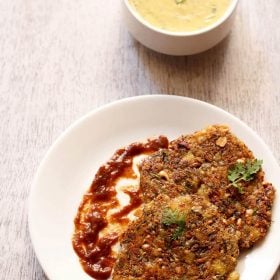

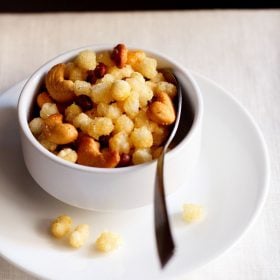
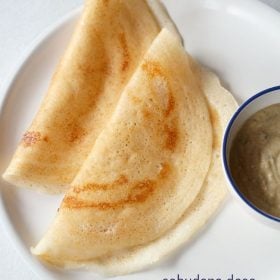

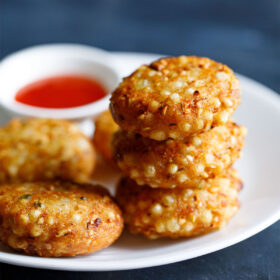
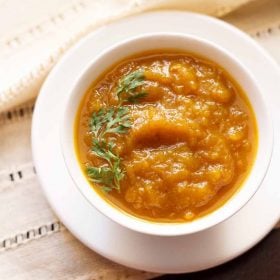
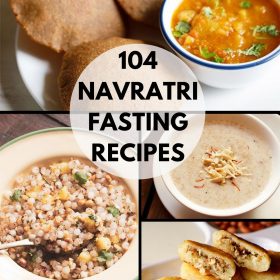








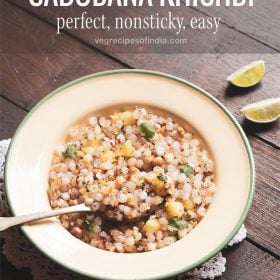
Loved your recipe and tips and the khichdi came out really tasty, thank you.
I just love your recipes. They are just yum.
Thanks a lot.
Love all your recipes! Thank you so much 😊
Thanks and most welcome.
Super recipe! Comes out very authentic. Thanks Dasanna.
Welcome Geetha and thanks for the lovely feedback and the rating as well.
Thank you so much Dassana.I’ve been using your site to learn how to cook vegetarian recipes from when I was a beginner to almost intermediate level now 😊.
Thanks a lot Spandana. Great and good to know. Most welcome.
It was yumm. I didn’t boil the potatoes, directly added in small chunks and roasted it on the pan. Thank you so much for the recipes!! It was delicious 😋
Thanks for the feedback and the rating. The potatoes can be roasted or even fried and added.
Thank you for your recipe . My grand children, children & I love this khichdi.
Good to know and thanks for sharing your feedback.
The complete process is very nicely explained ..I tried it myself as directed and the final outcome was fantastic.
Very tasty and healthy
thank you for this feedback. glad to know that the steps and pictures were helpful.
Your are recipes are tasty, accurately and well explained. Thanks so much for bringing out the Annapoorani in me! ????
most welcome sukanya. stay blessed always and thank you.
You are sooo Good!
Thank you for all the Awesome Recipes!
Each one of them here has been presented with Love – that truly transforms into the Dishes we prepare in our Homes 🙂
thank you very much samita. felt good to read your comment. thanks again and happy cooking.
Hello Dassana.
Thank you so much for such a beautiful recipe.
My sabudana pearls never get translucent. They stay white. What am I doing wrong?
welcome asha. could be due to the quality of pearls or maybe they need more soaking. are they cooked and softened or remain hard?
Namskar Tai,
This is Amit I am in catering business. Your blog is just amazing. Today I had made sabudana khichadi of 4 kg of sabudana using your receipy and it came out just amazing. A single pearl did not stick to kadhai. Your tips really helped me to make perfect khichadi. Thank you so much for all the details. Only one change i have made that is i fried peanut instead of roasting that gave nice taste to khichadi. Whenever i have to make something once i go through your recipe before the preparation.
namaskar amit. thanks for such detailed positive feedback and review on sabudana khichdi recipe. so glad to read that the recipe worked perfectly even when the proportions were increased. glad also that the tips helped to get that perfect non-sticky sabudana khichdi. i wish you all the best in your catering business.
All recopies are very well done
I have cooked them all and I really trust the recipes
Writer has taken lots of effort to make it easy to cook
awesome recipe dear thanks
Dear Dassana Ji, sorry to write so often on your website …. It is a bitterly cold winter ( -6 oC) and my daughter is visiting – and she eats only sabudana usli… so I had to make sabudana khitchdi, for the third time, this week. I followed all your instructions, … plus a sprinkle of hing (!), a teaspoon of Urad dal in the phodni, a quarter teaspoon of ground jeera ( – extra, to the jeera in the phodni – ) , a heaped tsp. of chilli powder, a generous sprinkle of MSG – mono sodium glutamate … and a teaspoon of dried curry leaf powder. I was out of fresh curry leaf – they are very expensive in the US, about $42 per pound at Whole Foods – so I decided to use the indian dried curry leaf powder …. it is not as good, but will do, in an emergency. The khitchdi was wonderful – according to my daughter. I have issued stern orders to her – 1) Learn how to cook indian food, and 2) get married ( she is 33 ! ) . She probably won’t do either …. she never listens to me …
Best wishes to you, your staff and all your readers. Belated Happy New Year.
no problem vidwan ji. you can always write. your comments have a lovely humor in them. loved the variations you made in the sabudana khichdi like red chili powder, curry leaves powder. i am not a fan of msg, so i do not add it in any food that i make, but yes i do know folks who swear by it as it perks up the flavors in the food. i was not aware curry leaves is so expensive in US. of course substituting curry leaves powder is a good idea.
best wishes to you and your daughter as well. hope whatever you want in relation to your daughter comes true ????
You can get curry leaves for cheap in an Indian store or just grow them in your backyard.
Hi Dassana, I am a South Indian and believe me my gujju friend was proud of this kichidi. Thank you sooo much 🙂 your blog is kinda the go to place for me when I think of cooking something outside the world. You have never failed me.
Loads of love and admiration from London
Welcome Chella. Thanks for your appreciation and positive feedback. Love and Regards.
Dear Dasana Ji, I made your ‘special’ sabudana, again. I soaked the sabudana pearls, ( 2 mm) with 1 /4 th inch water, left on top, for 8 hours, and they were perfect – soft and giving, to the touch, moist but dry, and did not stick to my fingers ! 😉
My wife has issued strict orders … no more than one small cup of anything ! ( I cook too much, and since there are only two of us, we have to throw the excess, out … which is bad and wasteful ;-( ….. So, I made up for that, by adding 100% of aloo. 😉
The sabudana khitchdi was perfect ! I came to your website, by habit, and since I know the instructions, by heart, I only read the headlines … 😉 ….. that was enough to boost my confidence. I added a teaspoon of wet coconut cream …. and two sprinkles of Hing, which I now notice, is not even there, in your ingredients 😉 …. anyway, no harm done, since I can’t taste the Hing, in the prepared dish. lol.
Best Season’s wishes to you and your ‘staff’ ( hubby ? ) … and to all the readers.
thats a lovely as well as humorous comment. potatoes can always be added more. more the better. glad that the sabudana khichdi worked for you. coconut cream is good and so is hing. some folks do add hing if not making sabudana khichdi for fasting.
best season’s wishes to you and your wife. thanks a lot.
Hi!!I soaked sabudana overnight and followed the recipe.But khichdi turned out to too sticky and gooey..where did I go wrong and how can I correct it..Me and my husband are very fond of sabudana khichdi but can’t cook it right!!Help..
shiba, after soaking using a strainer or colander drain all the water from the sabudana very well. there should not be any water left in the sabudana. also you can try soaking for less time. if the sabudana pearls become soft after soaking for 2 to 3 hours, then overnight soaking is not required.
thanks for the recipe ! by mistake i bought nylon sabudnana ! can i use that instead?
the smaller variety of nylon sabudana can be used, but not the large variety.
Just yummmmm… thanks for a great recipe yet again.
Welcome Harry
Hello Dassana mam,
I am a great fan of your recipes. They are just awesome. And the step by step pictures also help me a a lot.
Thank you so much for posting these wonderful and easy to make recipes. Keep posting. All the best!!!!!
Welcome Anahat. Thanks for your best wishes and for the positive feedback.
Excellent vrat recipe.

Mentioned this recipe in my blog
thanks subha. have removed your link as then the comment gets spammed. have added it in the url section.
is it must to soak it overnight…need to cook it for lunch today…plz
you can soak for a minimum 2 hours or if time is there, then soak for 4 hours.
Ur recipes r awesome but when i tried 2 make sabudana khichdi it was very sticky n lumpsy. I took barik wala sabudana 4 making khichdi.pls help me by guiding me hw 2 select sabudana 4 khichdi
if you use small sabudana, the you have to use less water for soaking and also drain it very well. after draining them, they should remain separate. looks like there was too much of water in the sabudana and thats why the khichdi became sticky and lumpy. use sabudana which is bigger than this sabudana. basically you get three types of sabudana. one is small, the other is medium which i have used and the third is a large one which is used for making sabudana chiwda.
Wonderful recipe.
By mistake we bought moti sabudana. Is it same as the normal. I made normal one innumerable times.. but saw this moti sabudana for first time. Please advice.
Thanksbin advance 🙂
welcome prerna, moti sabudana is used for making snacks like chiwda. you can make this sabudana chiwda recipe with them.
Thanks a lot once again ? for sharing the chidwa recipe 🙂
welcome prerna.
Superb recipe, i just added Two table spoons of curds after draining out the water. It tasted very nice. 5 star
glad raveen you liked the khichdi 🙂 thankyou so much.
Made it for the first time as my husband likes it! Turned out to be delicious… Thanks for this amazing recipe!
welcome amee. glad to know this.
Tried yesterday,during this navratre…came out just perfect…thank you …
thankyou so much shuchi 🙂 and you are welcome.
I tried this recipe today.. Added onion also along with other ingredients.. It was awesome!!!! Thank you 🙂
charitha thankyou glad to know you liked the sabudana khichdi 🙂 and you are always welcome.
Good
Greetings, I tried your wonderful recipe and I enjoyed the reading of it…. and the delectable photographs. The khichadi, itself, did not turn out so good, and it is 100% my fault. The sabudana, I get here, in the US, requires soaking for atleast 8 hours, and I soaked it for only 4 hours. So the grains were somewhat wet and humid and eventually, during cooking, turned out sticky and agglomerated. But the khichadi itself, tasted delicious. I omitted the ginger, since I have never used the spice in this recipe before.
in the NE USA, we have had no snow, this season, and it is 46oF ( ~8oC), which is very warm. Since we hate snow, we are grateful for this climate ‘warming’. Best Seasons Greetings to you and all your readers. Thank you and continue the good work. Love.
thanks. such things happen. we do make mistakes. even i do at times, especially in baking recipes. the stickiness could be that the there was lot of moisture in the sabudana. they need to be drained very well of the soaked water. thanks for your wishes and seasons greetings to you too.
Good, turned out tasty 🙂
thankyou jay 🙂
too good
thanku Dasana, its my sixth fast today, I m fed up of eating aaloo and curd, now I m having saboona khichdi which is toooo good, also I made tikki yesterday as instructed by u, that was also too good… thanku so much for sharing such a nice recipes….
thanks a lot shelly. you can try including amaranth, buckwheat and barnyand millet in your fasting food too.
Hi Dassana,
This is the best blog EVER for veg recipes.
Thanks for inspiring me to cook.
Keep up the good work and all the best.
quite pleased to know this veena 🙂 thankyou so much for your kind words.
Is there any substitute for peanuts ?
skip them or add chopped cashews.
Hi, can we use capsicum in fasting?
Thanks
welcome manisha. we don’t eat capsicum.
nice
recipe.thanks
welcome nilams
Dear Dassana
A quick reply for the soaking of Sabudana : wash the sago and for 1.5 cups of sabudana soak in 1/2 cup of water at night and in the morning sprinkle 3 tbsp. of water. Try and see. Sago will never get sticky.
On 19th August I came across your site and the pictures, presentation is superb. I am very poor in cooking vegetarian food and this site is like a savior, no need to get tensed about making of food. Any vegetables can be bought from market and just to cook by opening your site. Awesome. Thank you very much.
thank you much maria. also thanks for sharing the tip on soaking sabudana. usually i soak like the way i soak rice. because the quality of sabudana i get here is hard. if i soak in less water and keep overnight, then the sabudana remains hard and does not even softened the next day. but your suggestion will help the readers. thanks again.
Hi ,mam today i try sabudana khichdi ..i soak sabudana for 4 hrs ..but i think i use more water for soaking ..the khicdi become sticky ..can u please tell the amount of water used for soaking one cup of sabudana ..or plz tell where i ws wrong ..
hi rimple, you can just cover the sabudana with an inch of water on top. also remember to drain them very well. if they are not drained well, then they become sticky.
Thnx alot mam..i m addicted of your blog ..such a wonderful idea of coking with images yummyyy ..today i made motichor laddo and its also very tasty ..thanks for sharing your experience ..tc
welcome rimple. nice to know this. thanks for sharing positive review.
veryyyyyyyyyyy tasty!!!
thanks devika
Hi,
Thank you for your wonderful blog and for sharing information in such detail. I find your recipes to be most reliable. Let me share a few tips about sabudana khichadi that I have learnt over time with trial and error.
1. Wash sabudana thoroughly with water.
2. Soak fully in water for 15 minutes. Remove water and keep covered overnight.
3. Do not add more water in the morning.
4. While cooking, keep on fire for least amount of time and keep stirring.
5. If sabudana is soaked well, the cooking time can be minimized. This will prevent pearls from sticking to each other.
6. pulls lots of coriander leaves.
thanks pratima. also thanks for sharing these helpful tips. will help the readers.
For the first time I am happy with the taste and texture of the sabudana khichdi i prepared.Your recipe is so detailed and clear to follow, that the output has to be awesome.
Your blog is the one stop for all my cooking queries and recipes. Being a novice, following your recipes gives such a confidence to me in cooking.Earlier have also tried your pav bhaji recipe and it is a big thumbs up in my family 🙂
thanks reshu for sharing positive feedback on recipes. glad to know this. do try some more recipes.
Your blogs are my one stop destination for all recipes. Such a savior! This one is as amazing as the rest of them all. Thanks a ton.
welcome avani. thanks for your positive feedback on recipes.
Hi,
I want to make this for mugs sting days. Could you tell me if sea salt can be used instead of rock salt?
Thanks
Rina
yes you can add sea salt. since we make it for fasting, we add rock salt.
Is there any to know, beforehand, the time required for getting the pearls softened..like it needs just half an hour or overnight soaking etc., Thanks
welcome asha. check after 30 minutes or 1 hour. if they have softened then you don’t need to soak overnight.
My favourite go to website for cooking tips. Making this recipe as I am typing this. Thanks. Happy Shivratri!
thanks a lot mandira. hope your shivaratri was good.
nice recipe mam.bt its dry.my mom used tomake it wet or gravy type.that is lot softer.bt thanksto help me out
welcome raj. sabudana khichdi is always dry. your mom must be making a gravy version but i have never seen it.
I love the flavor of this dish, but I have a problem. I soaked the tapioca pearls overnight and many of them disintegrated. I went ahead and made the dish anyway, just to see how it would turn out, and the answer is: a bit of a gelatinous mess. I’ll eat it anyway, but I think the rest of my family will turn up their noses. What did I do wrong? Should I try soaking for just a few hours next time?
actually the soaking time depends on the quality of the pearls. i get really hard ones here and soaking them overnight, softens the. if i soak them for a few hours, they still remain hard. next time you can soak for just about 30 minutes. gently press one pearl and if it mashes easily, then they are soaked well.
For the soaking, make the water level half inch above the pearls.
I tried soaking about 30 minutes, it was not as soft as when we soak over night. May be it depends on the sabudana brand !!
thanks viju for your reply. i too always soak with the water level up.
Prepared sabhudana kichidi today but it came out very sticky. Had soaked it overnight and drained in the morning is that the reason. Tks
depending on the quality of sabudana , the soaking time may vary. also the soaked sabudana should be drained very well. there should be water in them. while cooking, just lightly saute. if you overcook, the grains may become sticky.
After u drain sabudana pearl, keep it to dry in open air for 30-40 mins to avoid stickynes
thanks sumit for sharing the tip.
I was looking for this recipe for a long time, you’ve explained it so well in details, I am gonna make sabudana khichdi with this recipe, I am sure it is going to come out well, I’ve earlier tried your poha recipe, it turned out excellent! ! Thank you! 🙂
welcome shanaz. all the best and happy cooking.
Good explanation Thank you very much
welcome prabhakar
Your recipes are a treat to try out! So well elaborated… it’s perfect…. thank u
welcome ashima
Nicely explained. I want you to explain the dish “Kaman Dokla” the same way as Sabudana Khichdi. (i.e step by step).
Thanking you in advance
welcome Shanti. OK, i will try to elaborate the dhokla recipe. i will have to update the whole post. thanks for the suggestion.
AWESOME RECIPE
thanks.
Whatttt a khichdi…!!!
How can u be so precised… i was trying different recipes for this since so many years… but today my day was awesome… sabudana khichdi was lovable.though i skipped ginger as my mother in law didnt allow.. u r just incredible… no place for confusions when dassana is here… keep going..!!… THANKYOUUU…
thanks monika for this awesome feedback on sabudana khichdi recipe. honestly speaking, it took me lot of time and trials to perfect this recipe… making sabudana khichdi is little tricky for beginners. but with practice, one can make delicious khichdi and have it on fasting days.
Hi dassana,
Very nicely explained as always… just one querry.. is ginger allowed in fasts? I am a north indian… pls do let me know. Also can this be made without ginger…pls guide..thnx
we use ginger during fasts. but some families do not. you can skip in this recipe.
Hi!
tried your recipe this evening. it was simple to make and the result was lovely too. thank u :).
welcome asmozonic
nice recipies
Hi Dassana,
this is a wonderful recipe and my favourite too.
my mom used to do this at maha shivaratri and vata savithri puja days…
we also make sabudana khichdi on mahashivratri, ekadashi and on most fasting days. thanks.
Ur all recipes are just awsome..I love it..
thanks shivani
Hi, Dassana !
I jst love this site !! keep it up ! The methods you mention here are so simple and hassle free. Yesterday I made sabudaana khichdi the way you mentiond and it turned out to be so delicious that it got famous in my office and evreryone appriciated a lot ! All thank to you !! 🙂 All the best !!
welcome ruchica. big thanks for this positive feedback on recipes. glad to know that everyone liked the sabudana khichdi recipe. you can try the buckwheat khichdi too. https://www.vegrecipesofindia.com/buckwheat-khichdi-recipe-kuttu-ki-khichdi/
I find sabudana khichdi so versatile. I can have it for lunch or dinner or I can snack on it or enjoy it for breakfast! Your khichdi looks perfect to the T.
thanks a lot for appreciating the recipe.
Hi! Dassana,
I was not able to make a sabudana khichdi… but ur recipe help me to make it. My mom loved it. Thanks a lot
welcome sapna. sabudana khichdi is a little tricky recipe. i am glad to know that u got it perfect.
I’ve been looking for a substitute for rice and I never even considered tapioca pearls. What a wonderful and interesting idea! I hope I can find the pearls to make your recipes
Hey Dassana , yuou have mentioned to roast the peanuts in a microwave. I have never tried that, always roast them in a pan. For how long do you have to keep them in a microwave for proper roasting?
Thanks 🙂
Nupur
hi nupur, i roast the peanuts in the microwave for 3-4 minutes.
nicely explained step by step.
I can see it is right way to do. I am inspired to make it and eat.
thx.
thanks sunny.
please subscribe to free recipes update at your email by following below link:
https://feedburner.google.com/fb/a/mailverify?uri=VegRecipesOfIndia&loc=en_US
Dear Dassana, just love your website and has been very useful to me….thanks a lot for the efforts…..as for the sabudana khichdi….i used to have a same problem where the khichdi used to turn soggy until i learnt is recipe from my aunt….. .first of all i cook the khichdi in fry pan…..it kinds of helps in keeping the pearls dry and seperated..besides having to use very little oil…. I have not mentioned the soaking procedure and quantites below as i fell you can use yours In a pan heat oil, add jeera and curry leaves and fry a little, then add potatoes cut into small cubes and fry on sim till the potatoes cook…alternately you can cover wih the lid to speed up the cooking….in the meantime mix together soaked and drained sabudana (like your recipe suggests above), crushed peanuts, chopped cilantro, salt, little black pepper powder, lal mirchi, chopped green chillies and mix this mixture with hand….keep aside….check if potatoes are cooked and once done add this mixture to the potatoes and mix well….check for salt and drizzle very little water on the mixture and cover and cook on slow fire for 2 mins….open, mix well and enjoy with roasted papad…
I hope this method helps in solving the problem of khichdi turning soggy
thanks a lot minal for the detailed method. i shall try making the khichdi this way. i found kshema’s method also very helpful.
Hey your recipes and the time of cook both just awesome. I really appreciate you for this.
thanks mansi
loved your site signed up for updates
thanks kalyani.
Dear Dassana,
I love your simple recipes. They turn out very well 🙂
I also used to face the same problem as yours with the sabudana. Then one of my neighbours in Pune showed me how to get separate sabudana pearls.
1. Wash the sabudana pearls in a colander under running water until you feel that all starch is rinsed and washed off.
2. Transfer the washed and drained sabudana to a casserole and sprinkle with little water, just enough to ensure that they are damp.
3. Cover the casserole tight and leave them overnight.
4. In the morning while you prepare for seasoning etc., check on the soaked sabudana and if required you can sprinkle little more water and leave for 30 mins more.
5. Have the peanuts roasted and ground to granules well before. Just before you start cooking, mix the peanut granules and salt with sabudana and rub the pearls well with the mixture.
6. Leave it for about 5 mins. and then add it to the seasoning you have prepared.
Since then I have been following this method and it is working well 🙂
Enjoy!!
thanks a ton kshema. i really appreciate your suggestions. these tips are going to make my life easier when making the khichdi. they will also help the readers who struggle to get the perfect sabudana khichdi. i am going to update the post with your suggestions. once again thanks a lot.
this looks so tasty..i never add coconut..but now will try this way..
do try shivani. with coconut the sabudana khichdi tastes too good.
I was so excited until I got to the grated coconut! My inability to find fresh coconut is driving me NUTS (no pun intended). So many interesting looking Indian recipes I am passing by! Grr. Anyway, this looks really yummy and really different from anything I have ever seen before. I have previously only seen tapioca pearls in desserts.
dear laura, you can even make the sabudana khichdi without coconut. coconut does add a lot in terms of taste & flavor, but without coconut also the khichdi tastes good. we also make puddings or kheer as we call them from tapioca pearls.
if you visit an indian store or even a regular grocery store that has a lot of spanish shopper you can find grated coconut in the freezer never use creamed cocunt as subsitute. line up all your coconut needeing recipes and cook away. in a pich you can use thr dry coconut powder or grated coconut in indian store which is unsweetened.
thanks for the response kalyani 🙂
I have tried the freezer section in the market that has great Indian selection. Maybe they were just out and I should try again…. Because I see another fantastic looking coconut recipe on the blog today. 🙂
Excitement!!!!!! I was at my favorite international grocery store today and I checked the Hispanic freezer instead o the Indian freezer and I finally found it!!!!!!!! YAY!!!!!!!!! So thanks a ton for the idea!
Thats great Laura. So now all those coconut based Indian recipes can be made soon 🙂
Love your recipie site..I have prepared many dishes from your blog…I love the way you have given step by step explanation with amazing pictures..
thanks shruti for trying out the recipes as well as liking the pics.
hey, I am fasting tomm…will make this for my breakfast..actually its not fasting its feasting as you mentioned..lol :)!